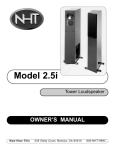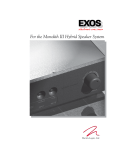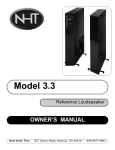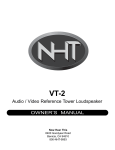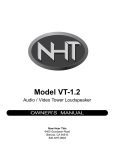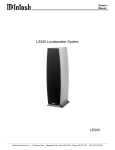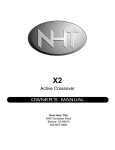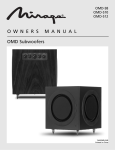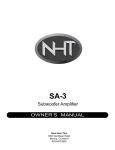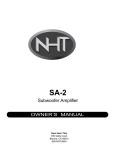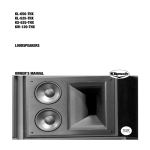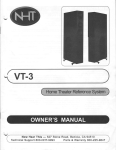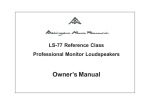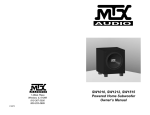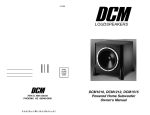Download NHT 2.9 Speaker User Manual
Transcript
Model 2.9 Tower Loudspeaker OWNER’S MANUAL Now Hear This 6400 Goodyear Road, Benicia, CA 94510 800-NHT-9993 Thank you for your purchase of the NHT Model 2.9 Tower Loudspeaker. Please take a few minutes to read through this Owner’s Manual prior to installing your new speakers. The information provided will help you to obtain maximum performance from your audio system. If you have questions or need assistance at any time during the installation or operation of your new speakers, please call your NHT Dealer or our Toll-Free Customer Hotline at: 1-800-NHT-9993 Please retain the Model 2.9’s packaging to protect the speakers in the event that you move or transport them. Model 2.9 Specifications · System Type: 4-way acoustic suspension design, Focused Image Geometry · Driver Complement: 10” polypropylene long-throw subwoofer, 6.5” polypropylene lower midrange, 4” polypropylene upper midrange, 1” fluid-cooled aluminum dome tweeter · Crossover: 100 Hz 12dB/octave high-pass and low-pass, 320 Hz 12dB/oct. high-pass & low-pass and 3.5 kHz 18dB/octave high-pass · Response: 26Hz - 26KHz, +/- 3db · Sensitivity: 87db (2.83V at 1M) · Impedance: 6 ohms nominal, 3.3 ohms minimum · Recommended Amplifier Power: 30W/ch minimum, 250W/ch maximum · Inputs: 1 pair of 5-way binding posts for woofer input 1 pair of 5-way binding posts for mid / high input · Weight: 78 lbs. each · Dimensions: 39"H x 7"W x 21.5"D · Finish: High gloss black, mahogany or sycamore laminate Specifications are subject to change without notice, in accordance with our policy of continuously upgrading the performance of our products. Design NHT loudspeakers are designed to deliver refined, musical sound from attractive and affordable packages. Our efforts are guided by the study of human hearing and are optimized for real-world use. Every NHT speaker undergoes rigorous testing and quality control at the factory to ensure you years of listening pleasure. The Model 2.9 is a unique 4-way loudspeaker based on the design of the NHT flagship Model 3.3. The 2.9 shares the same low-distortion upper range drive units, augmented by a custom-designed 10” sealed subwoofer with impressive excursion capabilities. All drive units are designed in-house by NHT for precise frequency and radiation characteristics, and are housed in individually sealed sub-enclosures within the 2.9 cabinet. Balancing the acoustic benefits of the 3.3’s radical cabinet design with a smaller, less demanding enclosure that fits into more environments, the 2.9 delivers exacting performance for the most discriminating listener. The Model 2.9 incorporates NHT’s proprietary Focused Image Geometry in a specially-designed enclosure that provides an optimal acoustic environment for its drive units. The upper range drivers are located on a narrow front baffle that extends out into the room, much like a minimonitor on a stand. This configuration minimizes room boundary effects such as side wall reflections, resulting in superior imaging and a natural tonal balance. Meanwhile, the 10-inch long-throw subwoofer is mounted on the side of the cabinet for consistent bass loading and to allow for the narrow front baffle. Focused Image Geometry design determines the 21-degree angle which defines the 2.9's unique cabinet, as well as the sound radiation pattern of the system. The irregular enclosure shape greatly increases the ratio of direct to reverberant sound, reducing side-wall reflections and concentrating sound energy in the listening area. The exact angles at which the sound from the speakers reaches the ears of centrally located listeners is calculated to create what is known in acoustics as minimum inter-aural cross-correlation. This technique allows the Model 2.9 to properly recreate the natural acoustic ambiance and perspective contained in good recordings. In addition, the radiating axes of the left and right speakers are crossed, providing time-intensity trading, so that the stereo image remains focused and stabilized for a wider range of listening positions. The cabinet shape also reduces the formation of internal standing waves, resulting in smoother midrange response. With the increasing popularity of home theater systems, many audio / video enthusiasts are building combined entertainment systems for both music and movies. When the Model 2.9 is used in a home theater system, be sure to augment it with timbre-matched speakers to ensure a seamless soundfield. The NHT AudioCenter-1 is the appropriate matching center channel speaker, while the Model 2.9, 2.5i or 1.5 will function as matching surround speakers. Alternately, the HDP-2 is a good choice for rooms where a full-range dipolar surround speaker is preferred. 2 Placement The Model 2.9 is a floorstanding tower speaker that requires no stands or mounting hardware other than the included SpikeKit. The Model 2.9 is designed for indoor use only. As the Model 2.9 is not a magnetically shielded loudspeaker, do not place it closer than 18 inches from a television. Unshielded magnets placed in close proximity to a television screen can cause discoloration of the picture. If you notice picture discoloration, move the speakers away from the TV until the problem disappears. The most impressive performance benefit of Focused Image Geometry is spectacular imaging and an expansive soundstage. To achieve this in your home, we recommend that the 2.9’s are situated 8 - 14 inches from the rear wall and at least 30 inches from the side walls. For smoothest response, the distance from the side walls should be different than the distance from the rear wall. The speakers should be arranged as symmetrically as possible, with their backs parallel to the rear wall and the drivers facing the listening area without obstruction from furniture. Arrange the speakers so that the distance between the listener and the center of the speaker plane is 1.5 times the distance between the speakers (fig.1). This configuration puts the listener in the center of the stereo image. Experimentation is the key to finding the best arrangement in your listening environment. Be patient, have fun, and remember that small changes in speaker position can sometimes have a significant effect on the sound. For example, moving the speakers nearer to a room boundary (walls, corners) will tend to increase their bass output, but may result in “boomy” or “muddy” sound. Conversely, placing the speakers farther away from room boundaries will tend to decrease their bass output, but may result in greater articulation and better imaging. In addition, room furnishings play an important role in absorbing and reflecting soundwaves. Midrange and high frequencies in particular will be absorbed by soft furnishings such as sofas, carpets and curtains. A large number of these soft furnishings will dull the sound, while a “live” room with few furnishings will brighten the sound. If you are willing to spend some time fine-tuning the performance of your system, you will enjoy the benefits for years to come. fig. 1 SpikeKit Installation A SpikeKit is included with the Model 2.9 to provide optimum stability and to firmly couple the speakers to the floor for improved bass performance. Each 2.9 loudspeaker is shipped with its own SpikeKit. Caution: the 2.9 is unstable without the SpikeKit (or at least the stabilizer bars) installed. To begin assembly, unpack the SpikeKit and inspect all the parts. The SpikeKit includes: (2) stabilizer bars, (4) metal cones, (4) Phillips head machine screws, (4) metal bolts and (4) rubber feet. We recommend installing the cones only after you have found the ideal location for the speakers. Begin by installing the stabilizer bars. Carefully turn the speaker upside down or on its back, and attach the stabilizer bars with the Phillips head machine screws, using a #3 Phillips screwdriver (fig. 2). Note: When installing the bars onto the bottom of the speaker, use your fingers to start all the machine screws in their holes before tightening them down. This will prevent crossthreading. Before installing the cones, turn the speakers upright and position them. Once you have found the ideal location, carefully tilt the speakers and screw in the cones. The speakers are awkward to move after the cones are installed. Caution: The cones are very sharp. To avoid injury, use extreme care when handling and installing them. Adjust the spikes as needed to ensure that the 2.9 is level and does not rock in any direction. Use the metal bolts to lock the cones in position. If you have hardwood floors or floors with a scratchable surface, you may choose not to use the cones because they will pierce the surface. Rubber feet are provided and can be used in place of the cones. Install the stabilizer bars, peel off the adhesive backings from the rubber feet, and place them over the holes where the cones would screw in. 3 Connections Before connecting speakers to your system, it is very important that you turn off the power to your amplifier / receiver to avoid damage to the equipment. The Model 2.9 loudspeaker system is compatible with virtually all quality amplifiers. Proper wiring of the speakers is essential to good sound. At a minimum, 14AWG speaker cable is recommended for runs of 10 feet or less, with heavier special purpose cable used for longer runs. For specialty cable considerations, consult your local authorized NHT retailer. For best results, use equal length runs of cable for the left and right speakers. Prepare your cable by stripping 1/4” to 3/8” of insulation from the ends and twisting the exposed wire strands tightly. The five-way binding posts on the back of the speaker will accept raw wire, banana plugs, or spade plugs. Tighten the binding posts by hand, as pliers can strip or break them. Be sure to wire both the left and right speakers "in-phase." That is, the Positive (red) terminal on the amplifier output must be connected to the corresponding Positive (red) terminal on the speaker. Likewise with the Negative (black) terminals. All speaker cables have some sort of marking along one or both conductors to help you make the correct connections. Incorrect speaker phase is indicated by weak bass and the lack of a well-defined stereo image. To minimize noise pickup, segregate cables by function. Do not run low level signal cables parallel to power cables, speaker cables, or digital cables. Also, do not run speaker cables or digital cables parallel to power cords or parallel to each other. If different types of cables are placed near each other at some place in your system, separate them by the maximum practical distance and cross them at right angles where they meet. Do not twist or tie AC power cords and speaker cables. Connection Methods fig. 3 On the back panel of the 2.9 there are two pairs of binding posts (fig. 3) with a metal jumper strap connecting the top and bottom pairs. There are three different ways to connect the 2.9’s to your system: full range with a single amplifier, biamplified with two amplifiers and two sets of speaker cable, or biwired with one amplifier and two sets of speaker cable. Full Range To run the 2.9’s full range with one amplifier / receiver, simply connect the speaker cables to either the top set or bottom set of binding posts (it doesn’t matter which one). Biamplification Biamplification is the use of two separate amplifiers, one to power the bass drivers and one to power the midrange / high frequency drivers. Biamplification provides increased dynamic range and power output, as it allows both amplifiers to concentrate all their headroom toward a specific frequency range, sparing them the task reproducing full range information. To biamplify the 2.9, you will need two amplifiers: a main amplifier for the upper range drivers (top pair of binding posts) and a second amplifier for the subwoofers (bottom pair). The main amplifier can be a stand-alone stereo amplifier, dual monoblock amplifiers, or the amplifier section of an integrated amplifier or audio/video receiver that features “pre-out” and “main-in” jacks. The second amplifier may be a full range amplifier connected parallel to the main amplifier, or for more flexibility, the NHT SA-3 subwoofer amplifier. Biamplifying with the SA-3 is highly recommended, as this configuration turns the passive subwoofer section of the 2.9 into a fully adjustable powered subwoofer with onboard bass tuning functions. The SA-3 is optimized for low frequency amplification and allows the user to fine-tune the 2.9’s bass response for a specific listening environment. For example, it is possible to increase or decrease the volume level of the subwoofer sections independently of the upper driver sections, to compensate for rooms that tend to under-emphasize or over-emphasize low frequencies. Additionally, the SA-3’s low-pass crossover allows the user to adjust the rolloff of low frequencies to the subwoofer sections for further fine-tuning of the low bass and mid-bass regions. Note: It is very important that you remove the jumper straps when biamplifying or you will damage your amplifiers! Connect the top pair of binding posts with speaker cable from the main amplifier, and the bottom pair of binding posts with speaker cable from the second amplifier. If you are biamplifiying with two full range stereo amplifiers that are not identical, make sure that one has an adjustable volume control so that you can match levels between the two. Both amplifiers will need to be wired in parallel from the preamplifier, so that they both receive an identical line-level input signal. If you are biamplifying with the SA-3 subwoofer amplifier, it may be connected in series or in parallel. For more detailed information, consult the SA-3 Owner’s Manual or your local authorized NHT retailer. Biwiring Some audio enthusiasts have found that biwiring can bring about improvements in sound. Biwiring is the use of two pairs of speaker cable and one amplifier, with each pair connected to one set of binding posts on the amplifier (some two-channel amplifiers provide two sets). To biwire the 2.9’s, connect the top pair of binding posts to the amplifier with one speaker cable, and the bottom pair with a second cable. The two sets of speaker cable are both connected to the same pair of terminals on the amplifier. 4 Operation The Model 2.9 was designed to handle a wide range of listening levels, but every speaker has limits. It is important to use common sense and listen for signs of possible distress from the speakers. Underpowered amplifiers are most often the cause of speaker damage. For example, a 60-watt amplifier runs out of power when called upon to produce more than 60 watts, and the resulting distortion can damage the speaker. If you tend to listen at high volume levels, more powerful amplifiers are preferable because they are less likely to run out of power. Noticeable distortion or harsh breakup is an indication that either your amplifier or your speakers are running beyond their capacity, and the volume should be decreased. If you can feel any heat emanating from the woofer or tweeter, reduce the level immediately. Speaker damage most often occurs from sustained high volume levels, not from transient sounds or brief musical peaks. Excessive boosting of bass, treble or equalizer controls can worsen the problem, and is not recommended. Maintenance Your speakers require minimal maintenance under normal use. The cabinet may be cleaned using a damp cloth or a mild, non-abrasive cleaner. To clean the grille, first remove it from the speaker, then brush lightly with a soft brush or use a vacuum on its lowest setting. Do not expose the speakers to direct sunlight, high temperatures, or moisture. Do not attempt to clean the actual drivers. Limited Warranty Valid Only in the U.S.A. Warranty Period For the period of 5 years for parts and 5 years for labor from date of original purchase (the warranty period) from an authorized NHT dealer, Now Hear This (NHT) warrants that if our product fails to function properly under normal use due to a manufacturing defect when installed and operated according to the owner’s manual instructions enclosed with the unit, it will be repaired or replaced with a unit of comparable value at the option of NHT without charge to you for parts or actual repair work. Parts supplied under this warranty may be new or rebuilt at the option of NHT. What’s Not Covered This warranty does not cover any product which is used in any trade or business, or in an industrial or commercial application. This warranty does not cover the cabinet or any appearance item, or any damage caused to the product resulting from: alterations, modifications not authorized in writing by NHT, accident, misuse or abuse, damage due to lightning or power surges, or being subjected to power in excess of the speaker’s published power rating. This warranty does not cover the cost of parts which would otherwise be provided without charge under this warranty, obtained from any source other than an authorized NHT service location. This warranty does not cover defects or damage caused by the use of unauthorized parts or labor or from improper maintenance. Altered, defaced or removed serial numbers void this warranty. Your Rights The liability of NHT will be limited to the purchase price of the product, and NHT will not be liable for incidental or consequential damages. NHT limits its obligations under any implied warranties under state laws to a period not exceeding the warranty period. Some states do not allow limitations on how long an implied warranty lasts, and some states do not allow the exclusion or limitation of incidental or consequential damages. The above limitations or exclusions may not apply to you. This warranty gives you specific legal rights, and you may have other rights which vary from state to state. To Obtain Service NHT has appointed a number of authorized service companies throughout the USA should your product ever require service. To receive warranty service, you will need to present your sales receipt showing place and date of original owner’s transaction. To find the name and address of the nearest authorized NHT service location, call or write: Customer Service Department, Now Hear This, 6400 Goodyear Road, Benicia, CA 94510. 800-NHT-9993. Please do not return product to this address. It is not a service location. Keep this warranty with your sales receipt. Record date and place of purchase for future reference. 5





